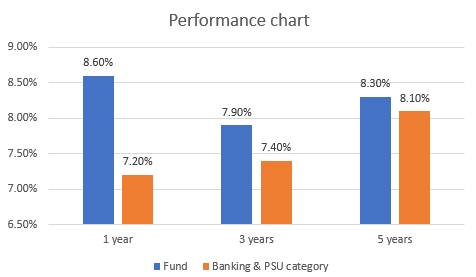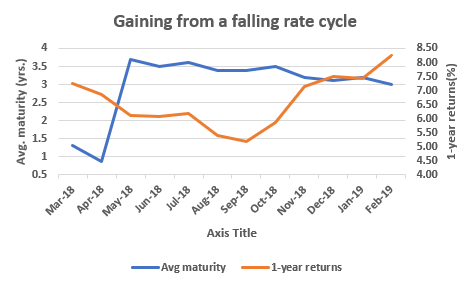Amidst all the risks that transpired in the debt space, in the last 6 months, Axis Banking & PSU Debt was among the few funds that remained steady and unhurt by the credit spook. Given its mandate to invest in bonds/deposits of banks and PSUs, the fund has largely kept itself away from credit risk. On the duration front, unlike many banking & PSU funds that dynamically change the portfolio maturity, this fund has seldom taken very long calls. As a result, it gains from rate decline scenarios adequately and does not get too hurt during rate hikes. This characteristic makes this fund a superior play in the entire short duration space.
Suitability
Investors wanting to use a debt fund as part of their asset allocation can invest in Axis Banking & PSU Debt. This fund is not a chart-topper over 3-year periods. But in a year like 2018, when equity and debt faced much pain, it can lend stability. You can use this fund for the following purpose:
- Act as a hedge for an equity-heavy portfolio.
- Hold for 2-3 years and use it as part of an income generating debt portfolio (using a systematic withdrawal plan) along with other ultra-short/short duration funds.
The fund requires at least a 2-year holding and is suitable for any long-term portfolio as well.
Performance
Axis Banking & PSU Debt is not a chart topper. But when compared with its own peers and the entire short duration category, it stands out on the following: One, among funds with low credit risk in the short duration space, it has the highest risk-adjusted return as measured by sharpe (on a rolling 1-year return basis for 3 years). Franklin India Short Term Income Plan and Baroda Short Term Bond are the only other funds with higher sharpe, but that comes from taking significantly higher risk.

Returns as of April 10, 2019
Two, the fund has delivered 1-month negative returns (in the past 5 years) in just 3% of the occasions. Among the better rated short duration funds, this is next only to HDFC Short Term Debt. Three, the fund’s size has grown 3-fold in the past 6 months at a time when funds are facing redemption pressure. Low credit risk, like other banking & PSU funds, but significantly higher risk-adjusted return appears to have increased investor interest in the fund.
Portfolio
Axis Banking & PSU Debt’s portfolio looks almost uninteresting, like a large-cap equity fund’s portfolio. The all-familiar names in the PSU space such as NABARD, SIDBI, NHAI, PFC, and SBI find a place in the portfolio. They are AAA papers and carry liquidity. While the fund has steadily held bonds/debentures of banks and public sector companies for a good while now, there have been times in the past when it capitalized on high-interest rates by investing in short-term certificates of deposits of banks as well.

Axis Banking & PSU Debt increased its average maturity early on, in June 2018, and suffered very short periods of 1-month negative returns as a result of an early call to up maturity. However, now, it’s average maturity of around 3 years gives it a marked advantage over other short duration funds, as the rate decline scenario can provide capital appreciation opportunities in the bonds it holds. Its current 1-year return of 8.6% is already higher than the 7.1% average in the banking & PSU category and the 6.5% return in the short duration space.
Unlike many peers in the banking & PSU space, the fund does not significantly up its average maturity. As a result, it has been less volatile than peers.
The fund is managed by Aditya Pagaria and had Rs 4581 crore of assets as of March 2019.







